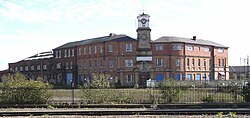Derby Works
 The North Midland and later Midland workshop in 2006 |
|
| Industry | Locomotive manufacturing |
|---|---|
| Founded | 1840 |
| Headquarters | Derby, England |
The Derby railway works comprised a number of British manufacturing facilities designing and building locomotives and in Derby, England. The first of these was a group of three maintenance sheds opened around 1840 behind Derby station. This developed into a manufacturing facility called the Midland Railway Locomotive Works, known locally as "the loco" and in 1873 manufacturing was split into locomotive and rolling stock manufacture, with rolling stock work transferred to a new facility, Derby Carriage and Wagon Works.
From its earliest days, it had carried out research and development in a number of areas, and in 1933 the London, Midland and Scottish Railway opened the LMS Scientific Research Laboratory. Around 1964, this became part of a new British Rail Research Division, based in the purpose-built Railway Technical Centre, which also housed the Department of Mechanical & Electrical Engineering (DM&EE) and later the headquarters of BREL.
Around 1840, the North Midland Railway, the Midland Counties Railway and the Birmingham and Derby Railway set up workshops to the rear of Derby station. Although the Midland Counties had an engine house at Nottingham, the main facilities for all three lines appear to have been, initially at least, those at Derby. That for the Birmingham and Derby was next to its line, near London Road. It was about 140 feet (43 m) long and 43 feet (13 m) wide, with three lines and three wide archways at its entrance, supporting a water tank. In one corner was a smithy. The Midland Counties' shed was rectangular and about 800 feet (240 m) long to the north of the site. Adjacent to it were water and coke facilities, and locomotive repair workshops. The North Midland's became a full repair facility, with a smithy, lathes and other machine tools. These were associated with what is believed to be the first Roundhouse, designed by Francis Thompson. On each side of it, in a vee, were workshops for locomotive and rolling stock repair.
...
Wikipedia
